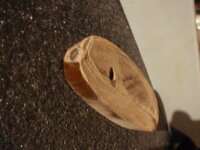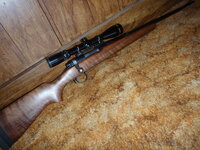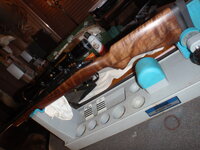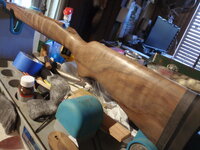Silver Supporter
Bronze Supporter
- Messages
- 4,210
- Reactions
- 6,918
Quite often in the course of human events when seeking to obtain a certain gun, one must buy another (or two) from the seller in order to acquire the actual one sought (or to convince one's self that some expense can be "made back").
Such may have been the case regarding a nice old '86 Winchester I was after, and then was "required" (by myself or the seller) to also take a Remington shotgun and what seemed to be left of a Remington .257 Roberts.
Technically, it did not qualify as a textbook "basket case", since it was after a fashion "assembled" with what appeared to be all its parts. That was the only thing going for a rusted, butchered and shade-tree"fixed" gun. I now regret that I took no "before" pictures and narrative will have to suffice.
Fuzzy with rust from muzzle to receiver, the seller said it had been in the trunk of Grandpa's car for a few years. But it could be recognized by the round bolt handle and front sight as a Remington Model 722. The stock seemed to be coated in Spar Varnish of multiple coats, done WITH the action on the wood. (Generous amounts of varnish had happily leaped on to fresh pastures of steel.) Large gouges existed on the comb and on the forearm, as if the rifle was in a truck rack while the Spar Varnish dried (a required time period of weeks).
Attached to the butt end was NOT the checkered aluminum Remington original plate, but a good ol' Pachmayer. But its final "fitting" (a term used and exhibited here loosely) was actually done with a penknife, most probably on a deer stand. The edges of the base of the pad resembled the chipped edge of an Indian arrowhead. Perhaps the erstwhile craftsman was just as proud as the pad was above the contour of the buttstock.
The butttstock showed a gaping hole with longitudinal chips where the butt sling swivel stud had once resided far too close to the edge of the butt, exacerbated by a horribly crude cut (of visible levels, starts and stops) done when the pad was "attached". Holes for pad-mounting screws were overly numerous and "wowed" out. Grandpa had done what Grandpa could afford with the tools at hand.

The only "before" picture in existence, this is the buttstock section amputated, showing multiple enlarged screw holes and a chipped sling stud orifice right at the edge, and the "mating surface" to the pad.
After-market wood stocks pushed the $500 mark with add-ons. Three applications of heavy volatile varnish remover showed the original stock to be salvageable...perhaps. It is rare to find a 722 stock that does not have a "cut-out" for the receiver peep, and this was one.
It was decided to amputate this 1/2" section of the butt replete with problem areas. Yes, glass/epoxy could have repaired most, but the chipped sling stud hole would ALWAYS show as a repair. Best to start clean, wood spacers never look right, so a plain black spacer would be installed ahead of a new Pachmayer Presentation. Any future owner of small stature (child, female) will find an easy conversion to a shorter length of pull with only minor re-fitting of the pad.
Metal was disassembled, and each part soaked, then gently massaged with solvent-dripping steel wool. A striking testimony to old-school bluing salts and gun oil, the action re-assembled showed NO rust.
More attention to the wood started to look like some scary pretty got out of the Remington wood shop in 1953.
Brownell's Acra-Glas Gel went into the recoil lug recess and just enough forward for a pad under the chamber, barrel floated. ('cuz a Roberts deserves it.)
Leupold Short Action STD Bridge Mount and a Vari-X III 3.5-10 (which showed up on NWFA right when I needed it!) became its new eyes.
...and "Ol' Bob" is back from Spa Treatment and lookin' like a new man!


Such may have been the case regarding a nice old '86 Winchester I was after, and then was "required" (by myself or the seller) to also take a Remington shotgun and what seemed to be left of a Remington .257 Roberts.
Technically, it did not qualify as a textbook "basket case", since it was after a fashion "assembled" with what appeared to be all its parts. That was the only thing going for a rusted, butchered and shade-tree"fixed" gun. I now regret that I took no "before" pictures and narrative will have to suffice.
Fuzzy with rust from muzzle to receiver, the seller said it had been in the trunk of Grandpa's car for a few years. But it could be recognized by the round bolt handle and front sight as a Remington Model 722. The stock seemed to be coated in Spar Varnish of multiple coats, done WITH the action on the wood. (Generous amounts of varnish had happily leaped on to fresh pastures of steel.) Large gouges existed on the comb and on the forearm, as if the rifle was in a truck rack while the Spar Varnish dried (a required time period of weeks).
Attached to the butt end was NOT the checkered aluminum Remington original plate, but a good ol' Pachmayer. But its final "fitting" (a term used and exhibited here loosely) was actually done with a penknife, most probably on a deer stand. The edges of the base of the pad resembled the chipped edge of an Indian arrowhead. Perhaps the erstwhile craftsman was just as proud as the pad was above the contour of the buttstock.
The butttstock showed a gaping hole with longitudinal chips where the butt sling swivel stud had once resided far too close to the edge of the butt, exacerbated by a horribly crude cut (of visible levels, starts and stops) done when the pad was "attached". Holes for pad-mounting screws were overly numerous and "wowed" out. Grandpa had done what Grandpa could afford with the tools at hand.

The only "before" picture in existence, this is the buttstock section amputated, showing multiple enlarged screw holes and a chipped sling stud orifice right at the edge, and the "mating surface" to the pad.
After-market wood stocks pushed the $500 mark with add-ons. Three applications of heavy volatile varnish remover showed the original stock to be salvageable...perhaps. It is rare to find a 722 stock that does not have a "cut-out" for the receiver peep, and this was one.
It was decided to amputate this 1/2" section of the butt replete with problem areas. Yes, glass/epoxy could have repaired most, but the chipped sling stud hole would ALWAYS show as a repair. Best to start clean, wood spacers never look right, so a plain black spacer would be installed ahead of a new Pachmayer Presentation. Any future owner of small stature (child, female) will find an easy conversion to a shorter length of pull with only minor re-fitting of the pad.
Metal was disassembled, and each part soaked, then gently massaged with solvent-dripping steel wool. A striking testimony to old-school bluing salts and gun oil, the action re-assembled showed NO rust.
More attention to the wood started to look like some scary pretty got out of the Remington wood shop in 1953.
Brownell's Acra-Glas Gel went into the recoil lug recess and just enough forward for a pad under the chamber, barrel floated. ('cuz a Roberts deserves it.)
Leupold Short Action STD Bridge Mount and a Vari-X III 3.5-10 (which showed up on NWFA right when I needed it!) became its new eyes.
...and "Ol' Bob" is back from Spa Treatment and lookin' like a new man!














